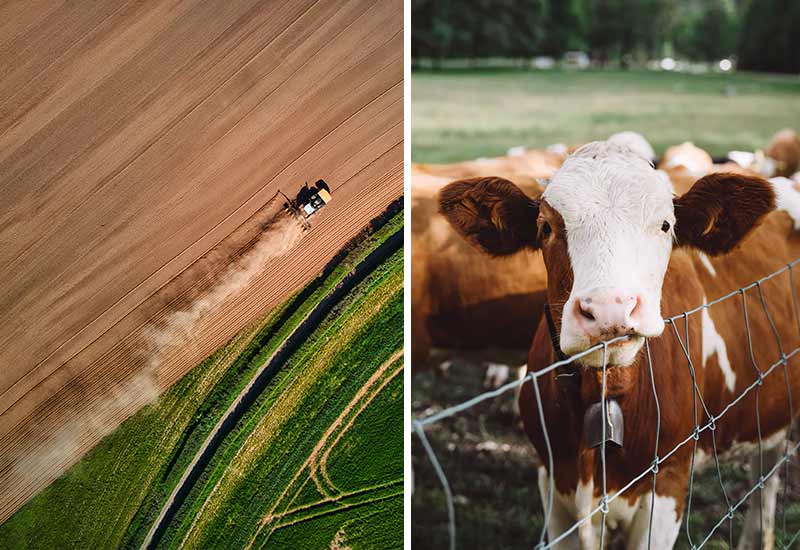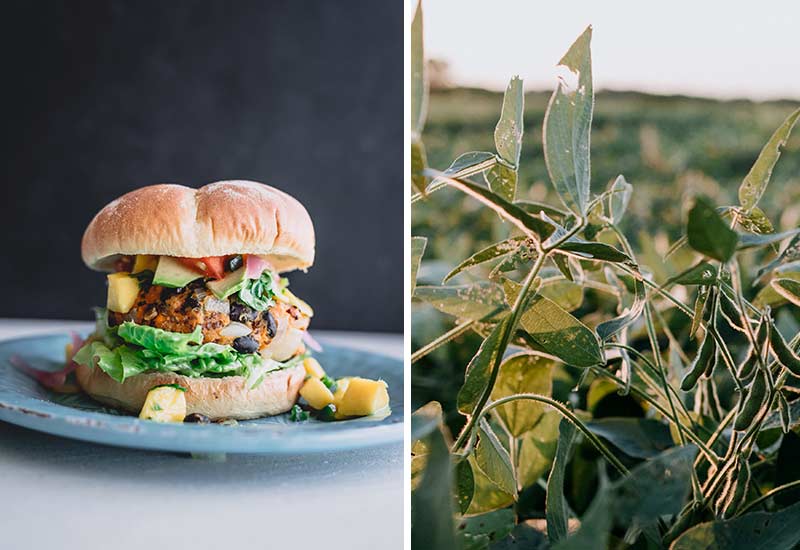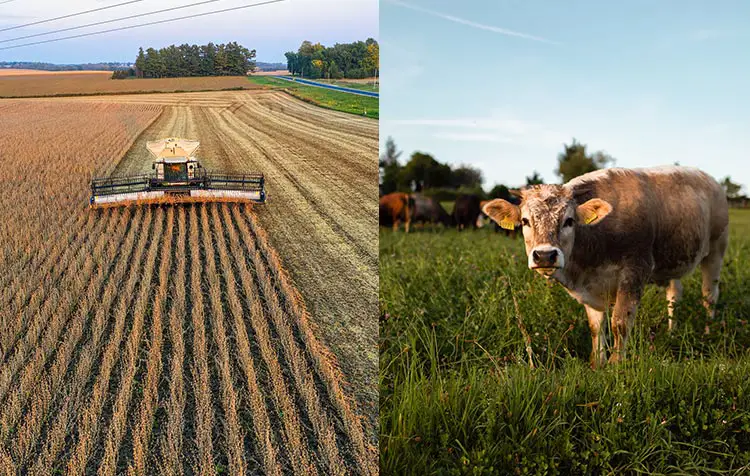Want to learn more about land use for meat, eggs and dairy products? Then you've come to the right place! Whether it's steaks, cheese, potatoes or tomatoes - food doesn't grow in the supermarket, but has to be produced at great expense. While plant-based foodstuffs are simply grown, harvested and consumed on arable land, the land required for animal products is much higher, for example, due to the animal feed, pasture land or stables. In times of Climate change, the Deforestation of the rainforests and of the Species extinction this is a massive problem.
In this article, I'll explain why meat, eggs, and milk are so land-intensive - and why the world's population could be fed with about a quarter of the land currently used to produce food. Let's go!
In advance you can find a short overview of the article here:
Facts & figures around the land consumption of meat and animal foods
First of all, it is important to consult meaningful statistics to get a clear picture of land use for meat production - and all the facts related to it. Here are some figures that give a sense of the current extent and its evolution:
What is the global area of agriculture?
Agriculture is practiced on more than one-third of the earth's habitable surface.₁
What is the land footprint per person?
In Germany, the average food-related per capita land footprint is 2,022 square meters per year. 180 square meters of this is grassland and 1,842 square meters is arable land.₂
What food categories does the land footprint break down into?
54.4 percent of the average land requirement per capita is for meat and sausage, 20 percent for milk, cheese, eggs and other dairy products. 0.2 percent of the land requirement is for the production of fish feed for fish farming - and 24.4 percent is required for plant-based foods.₂
How much arable land is farmed for animal feed production?
Already today, 30 percent of global arable land is farmed solely for the production of animal feed, such as soy, wheat or maize.₂
How large is the global soybean cultivation area?
Soybean is grown on 2.84 million hectares of arable land worldwide. 2.73 million hectares (approx. 96.13 percent) of this is cultivated for the production of animal food - and only 0.11 million hectares (approx. 3.87 percent) for the production of plant food.₂
What proportion of the farmed arable land is used for the production of animal foodstuffs?
83 percent of the total area required for our food is used for the production of meat, sausage, milk or eggs and other animal foods.₇
To what extent is the area available for agriculture becoming smaller?
Erosion, salinization, pollution and sealing are reducing the amount of available arable land. Already today, 52 percent of our global arable land has been destroyed or is at risk.₂
How much land is each inhabitant of the earth entitled to for food?
Today, each inhabitant of the earth has approximately 2,000 square meters (= 0.2 hectares) available for growing food. In 2050, however, this will probably be only 1,700 square meters.₄
How does today's agricultural economy affect biodiversity and deforestation?
Globally, agriculture is responsible for 70 percent of biodiversity loss and 80 percent of the Deforestation responsible.₃
How much land does Germany's diet take up abroad?
Around 18.2 million hectares of land are occupied abroad for food products imported into Germany. This figure rose by 38 percent from 2000 to 2010 alone.₅
Why is land consumption for meat and other animal foods so extremely high?

The world's hunger for meat can only be satisfied by dedicating land to the production of meat. Animal feed cultivation and pasture opens up. Cattle even require about 28x more land than poultry or pork, for which animal husbandry is of course also land-intensive.₆
A remarkable statistic makes it particularly clear why the Factory farming essential to the biggest environmental problems of our time but also the potential that lies dormant in adapting our diet: 83 percent of the area used for agriculture are necessary for the production of animal products (about 26 percent of the earth's land area) - but the cultivation of this arable land produces only 18 percent of caloriesthat we humans absorb as a whole.₇
These numbers are especially tragic, considering that the available fertile arable land is declining (e.g., due to Soil erosion, desertification or flooding) and the World population continues to grow. A plant-based diet would simply be much more resource and calorie efficient.
Why does veganism reduce the land footprint per person?

According to a extensive study of the University of Oxford, 75 percent of the world's arable land could be used for other purposes., when humanity vegan would feed. It is simply the "animal detour" that takes up so much land area in our diet. If we would consume the grown plants directly and not feed them to animals to eat afterwards, land consumption would decrease significantly.
A lot of subjunctive - especially as global meat production increases. But the Changing the way we eat is fortunately running at full speed, as the ecological, health-related and above all also ethical Motives for veganism are so diverse and plausible. The change is all the more needed when you consider that countless amounts of animal food are produced "for free" because they end up in the garbage can.
Tip: How you can change your Reduce personal food waste you can find out in the linked article.
What opportunities and benefits do the reclaimed land areas hold for life on Earth?

Only a small proportion of the nutrients that cows, pigs or chickens take in via animal feed end up in meat later on. So feeding the world with plants would definitely be more efficient - plus it conserves natural resources. But to what extent are there advantages for life on earth when we humans only a quarter of the land area currently cultivated for our food? Here are some of the positive consequences of reducing the amount of land needed for food:
- Biodiversity: Fewer fields and arable land mean more habitat for animals and plants. Due to exorbitant meat consumption, the habitat - and thus also the biodiversity - declined more and more so far. The decision for the vegan lifestyle therefore helps to Stop species extinction.
- Halting deforestation: Eliminating animal-based foods would also curb (illegal) deforestation of rainforests for animal feed crops and pasture, while protecting indigenous peoples from conflict and displacement. Vegan you live namely also for people - and not exclusively for animals.
- Climate protection: The reforestation of land that has been freed up binds more CO2 again. Since factory farming is on the decline, emissions are also lower at the same time. The Climate protection in everyday life also ensures that less agricultural land is lost - due to desertification, for example.
- Fighting world hunger: It is estimated that we could feed about 3.5 billion more people if we consumed the livestock food ourselves.₈ Accordingly, direct consumption and the land gained help to reduce the End world hunger at last.
- Stop land grabbing: There is great competition for land in countries such as Brazil for the production of meat and other animal foods. Foreign corporations buy up large areas of land in such developing countries in order to grow products there for export (e.g. soybean meal as animal feed).₉
Can you think of other benefits of using less land for meat? Then feel free to write me a comment under this article.
Everyone can reduce the amount of space needed for their own meals!
Every piece of meat on our plates contributes to destroying species-rich ecosystems like the rainforest and preventing the reforestation of new land areas. We need to ask ourselves: are the 10 minutes of enjoyment really worth endangering the planet, the animals and ultimately ourselves and the future of our children and grandchildren?
Every day, each of us has the opportunity to minimize the amount of land we use for our own diets - and make a real difference for biodiversity, climate and forest protection, and social justice.
Do you have any questions or tips about land use for meat and other animal-based foods? Then I look forward to your message in the comments column.
Stay sustainable,

PS.: You want - apart from the area requirements - your Making nutrition even more sustainable in principle? Then you will now get many more valuable tips in the linked article. Have fun!
References:
₁ WWF (2020): Living Planet Report 2020, available at https://www.wwf.de/living-planet-report. [21.01.2022].
₂ WWF Germany (2021): Klimaschutz, land- wirtschaftliche Fläche und natürliche Lebensräume, available at https://www.wwf.de/fileadmin/fm-wwf/Publikationen-PDF/kulinarische-kompass-klima.pdfhttps://www.wwf.de/fileadmin/fm-wwf/Publikationen-PDF/kulinarische-kompass-klima.pdf. [21.01.2022].
₃ Intergovernmental Panelon Climate Change (2020): Climate Change and Land: An IPCC Special Report on climate change, desertification, land degradation, sustainable land management, food security, and greenhouse gas fluxes in terrestrial ecosystems, Summary for Policymakers, available at https://www.ipcc.ch/site/assets/uploads/sites/4/2020/02/SPM_Updated-Jan20.pdf. [21.01.2022].
₄ FAO(2012): World Agriculture Towards 2030/2050, The 2012 Revision, In: ESA Working Paper, No. 12-03, available at http://www.fao.org/3/ap106e/ap106e.pdf. [21.01.2022].
₅ Birger Nicolai: Germany is dependent on agricultural fields abroad (as of 19.08.2013), available down https://www.welt.de/wirtschaft/article119159181/Deutschland-ist-abhaengig-von-Agrarfeldern-im-Ausland.html. [21.01.2022].
₆ Claudia Tam: How Veganism Can Help Ease the World's Land Use Crisis (as of Dec. 22, 2020), available at https://earth.org/veganism-land-use. [21.01.2022].
₇ J. Poore, T. Nemecek (2018): Reducing food's environmental impacts through producers and consumers, available at https://www.science.org/doi/10.1126/science.aaq0216. [21.01.2022].
₈ Things Explained - In Brief: Meat - The World's Tastiest Evil, YouTube, Jan. 24, 2019, web, Jan. 21, 2022 at 10:03 a.m., in: https://www.youtube.com/watch?v=y6f3dwxexZM.
₉ SÜDWIND e.V.; Irene Knoke, Friederike Niewerth: Flächenkonkurrenz: das Beispiel Fleisch (Stand: Oktober 2013), abrufbar unter https://www.suedwind-institut.de/files/Suedwind/Publikationen/2013/2013-13%20FS%20Flaechenkonkurrenz%20-%20das%20Beispiel%20Fleisch.pdf. [21.01.2022].





